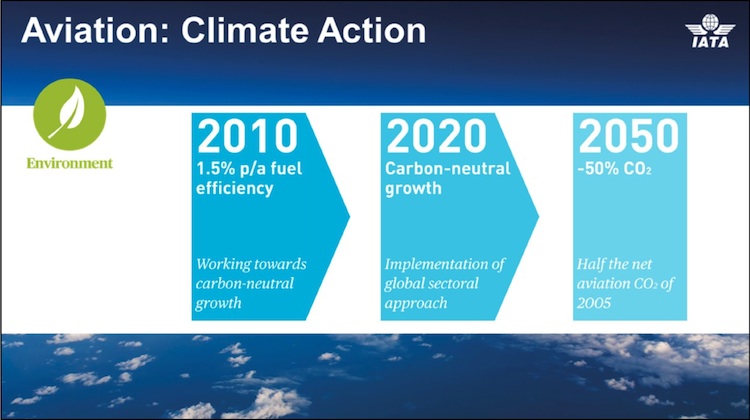
Newer, more fuel efficient aircraft and changes to operating procedures have helped the global airline industry reduce fuel consumption and carbon dioxide emissions as the sector moves towards carbon neutral growth.
In 2009, the International Air Transport Association (IATA) said it aimed to reduced carbon dioxide emissions by 50 per cent by 2050, compared with 2005 levels. To meet that goal, two intermediate steps, or targets, were also identified.
The first step was an average improvement in fuel efficiency of 1.5 per cent per year from 2010 until 2020.
The second step was a cap on carbon dioxide emissions, or carbon neutral growth in an environment where passenger traffic was growing between four and five per cent a year, from 2020.
There have been four key areas of focus, covering new technology, more efficient operations, better infrastructure and a global market-based measure on emissions.
IATA senior vice president Paul Steele says the introduction of latest generation aircraft and the engines that power them into the fleets of airlines around the world has had a dramatic impact on improving fuel efficiency, given the 15 to 20 per cent reduction in fuel compared with the aircraft that they replace.
And on the operational front, changes to aircraft descent profiles, the replacement of bulky paper flight manuals with lightweight tablets such as iPads and use of new electric tow tractors have all made a big contribution to carbon dioxide reduction.
Steele said the global airline industry had so far achieved a 2.9 per cent reduction in fuel consumption per annum, well above the 1.5 per cent target.
“In general we are on track to more than achieve the target that we set,” Steele told reporters during a media briefing at the International Air Transport Association annual general meeting in Miami on June 9.
However, Steele cautioned that the figure had been boosted by the parking of aircraft during the global financial crisis.
Nonetheless, there were potentially more gains to be made through better infrastructure – both in the air and on the ground – with the help of national governments.
“You can have the most fuel efficient aircraft but if it is circling around for half an hour before it can land, naturally that is creating fuel burn and emissions that are unnecessary,” Steele said.
“So we are working with governments and pushing very strongly on modernisation of air traffic management, making sure we have the right infrastructure both in the air and on the ground.”
There was also significant ongoing investment in developing alternative fuels produced from waste materials, with production ramping up as some airports commit to getting a percentage of their fuel from alternative sources.
“It is now a question of commercialisation of those fuels so that we can get the quantities we need in order to be able to supply the industry around the world,” Steele said.
“I think the real promise here is it has gone beyond technical concepts, it’s gone beyond testing. We know they are safe, we know we can use them.
“It is really now about increasing production and commercialisation.”
Although the recent fall in global oil prices had made the commercialisation of biofuels “more of a challenge”, Steele said oil prices were unlikely to stay low forever.
Moreover, the cost to produce alternative fuels would continue to fall and potentially “match and maybe even improve on traditional fuel costs in the medium term”.
In addition to all the advancements on the technology, operational and infrastructure side, the International Civil Aviation Organisation (ICAO) and its 190-odd member nations were working on a global market-based measure to help offset carbon dioxide emissions.
Steele said much progress had been made since the global agreement on a need for a market-based measure was reached in 2013, with a scheme due to be put forward at the ICAO assembly in 2016.
Feedback from five regional workshops held recently to get more feedback showed “there was strong support from all countries”.
“You didn’t hear one country say ‘We think this was a bad idea’,” Steele said.
“We are pretty optimistic that there will be an agreement next year.”
















Marc
says:I have to laugh at this ridiculous IATA Climate Action paper.
In another story, Boeing is producing 38,000 new aircraft next 20 years on top of all the other aircraft makers. The fact is, there will be many times more aircraft in 20 years, wiping out hopes of any incremental efficiency gains.
GAGA
says:So step one, a 1.5% improvement in efficiency per year between 2010 and 2020 totals a 15% efficiency improvement but in that time air travel will surely have grown by at least 15% meaning total emissions won’t really change.
Then step two with a cap on emissions from any growth in air travel between 2020 and 2050 meaning that by 2050, emissions will still be at 2020 levels.
How do those two steps suddenly lead to a 50% drop in emissions by 2050?